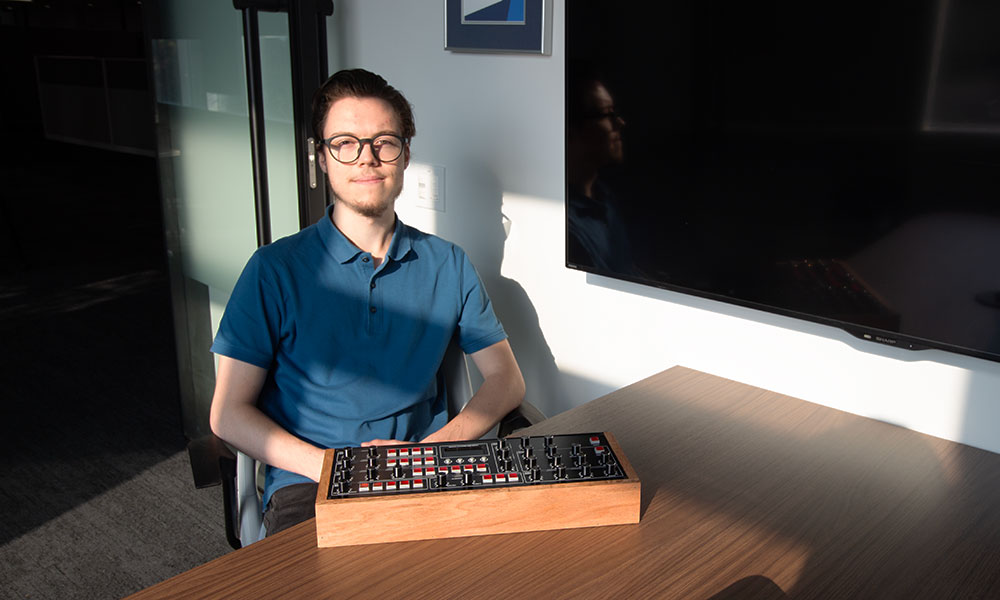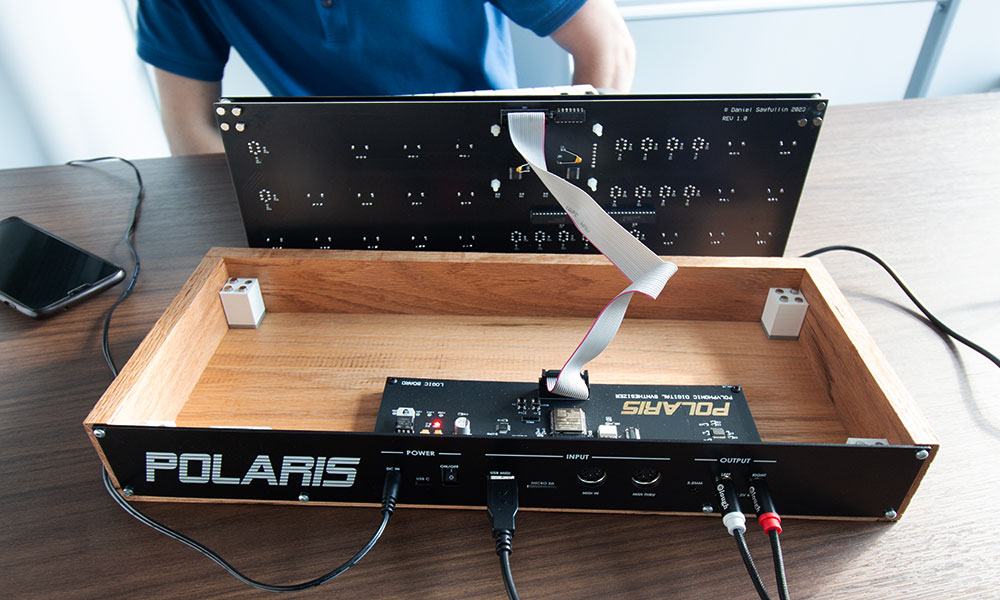‘Limitless possibilities’ see grad shortlisted for major award
After turning knobs and pressing buttons on a compact console on the table in front of him, Daniel Sayfullin (Electronics Engineering Technology ’23) turns his attention to the keyboard beside it and plays a few tension-filled chords.
“Do you recognize that?” he says, glancing up and smiling.
I do not.
“Knight Rider,” he says, meaning the theme from the mid-1980s crime drama.
Sayfullin switches to a snippet from Michael Jackson’s Thriller. Then he starts improvising, bending notes with a pitch shifter on the keyboard and returning to the console to turn more knobs and press more buttons. Finding a sound he particularly likes, he pauses to grab his phone and take a photo of the settings.
“It’s all in the musician – twiddling the knobs, getting the sound just right. There are limitless possibilities.”
That console is a synthesizer called the Polaris – an instrument Sayfullin designed and built during a 15-week capstone project in his final year at NAIT. He was inspired by the Prophet 5, the world’s first fully programmable synthesizer, dating from the late-1970s, which leant its distinctive sound to much of Jackson’s 1982 smash album along with a raft of other songs of the day (and probably more than a few TV show themes).
I wonder aloud if it could be used to mimic riffs from a certain Canadian rock trio well known for early-’80s hits that embraced electronic keyboards.
“Potentially, yes,” says Sayfullin. “It’s all in the musician – twiddling the knobs, getting the sound just right. There are limitless possibilities.”
For offering those possibilities – in the form of thousands of distinct sounds from a single handmade and highly refined instrument – the project was nominated for the capstone of the year award by ASET, the Association of Science and Engineering Technology Professionals of Alberta. The announcement, made this September, was music to Sayfullin’s ears.
A ‘stunning’ amount of work
“I’m an engineer first and foremost, musician second,” says Sayfullin.
Partly, that’s because the 20-year-old technologist doesn’t quite know how to play.
When he first heard the Prophet 5, Sayfullin was driven to understand its sound in terms of how it was produced by its electronic components. Before coming to NAIT, back when he was a high school student studying robotics, Sayfullin dreamt of recreating the warmer, richer tones those analog parts are said to make. But he wanted to do it digitally, using chips and programming instead of oscillators, filters and the like, eliminating parts that could wear out or break.
He also wanted to do that for course credit. “It was more or less possible within that time frame,” Sayfullin says, referring to the final term when capstones run alongside classes and coursework.
But building the Polaris proved to be an orchestral feat of careful coordination, unwavering self-discipline and late nights.
“There was a very large amount of tasks to get done, so I had to really manage my schedule … and not procrastinate,” says Sayfullin.

As he expected, the toughest job was working through coding and algorithms to emulate the sonic behaviour of an analog synthesizer. In addition, Sayfullin had to source and assemble all the parts, from the aluminum control panel he had custom-made by a company in Nova Scotia to the red-oak casing he built with a carpenter friend.
When Sayfullin first proposed the build as his capstone project, instructor Cory Thorp (Electronics Engineering Technology ’16) had concerns about the workload. But knowing the student’s talents and dedication, he set those aside.
“It was clear that he wasn't going to be deterred,” says Thorp, “and I wanted to encourage that.”
Thorp’s faith proved well placed. “It’s absolutely stunning the level of work that went into this. I'm kind of shocked that a single person would be able to pull this off.”
"He wasn't going to be deterred.”
While the Polaris physically resembles the Prophet 5, it’s more homage than replica – which, being realistic given the time and resources, was Sayfullin’s goal.
“If I set up the knobs in the same way as a Prophet 5 and get a similar sound, then I feel like I've succeeded in that respect.” As assurance, “I got full credit,” Sayfullin adds.
“I would have expected much, much less and he still could have gotten an amazing grade,” says Thorp. “He really was reaching for the stars on this.”
The path forward

Sayfullin named his synthesizer with intention. Polaris is the north star, he points out, which has helped direct travellers throughout the ages toward their destinations.
“I felt like this project was the path forward for me in this program,” says Sayfullin.
Whatever happens with the ASET award, the winner to be announced in October, he knows the synthesizer build will help his resumé. “It’s the fact that I built it from scratch, the work that I put into it, the design, [and] the fact that I could complete this on time, that really speak to my abilities as an engineer who’s able to deliver on projects on time.”
But there’s a chance the Polaris could guide Sayfullin even farther.
With an investor, he’d be open to taking the instrument to market. It would be an expensive undertaking, Sayfullin acknowledges, but he believes he could retail his synthesizer for around $1,000 – whereas the reissued version of the Prophet 5 sells for almost $5,000 (an original can demand upwards of $15,000).

“It is very close to being a finalized product,” says Thorp, whose instruction includes prototyping. “Which again just speaks to the quality level.”
Perhaps one day, the Polaris might do for others what the Prophet 5 did for Sayfullin, which was to catch his ear, intrigue and inspire him. He may be an engineer first but he knows that a song’s power lies in more than the properties and propagation of sonic waves.
The value of the Polaris, he feels, could be its role in “just bringing joy to people – dancing, having a great time with music,” says Sayfullin. “Music is an essential part of people’s lives. This helps bring [them] happiness.
“And I don't think that we have enough of that in the world.”
Learn more about this project from ASET